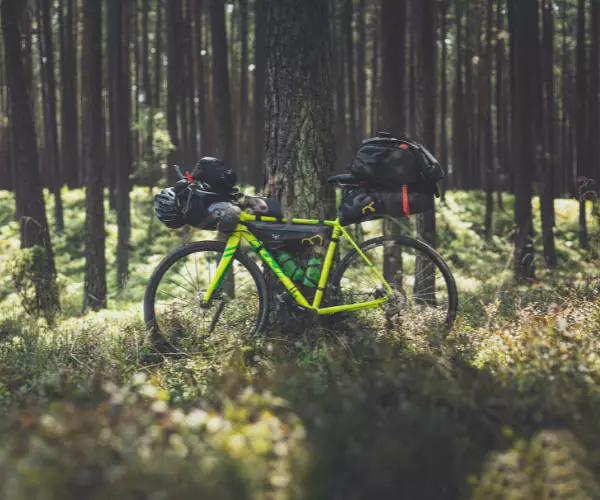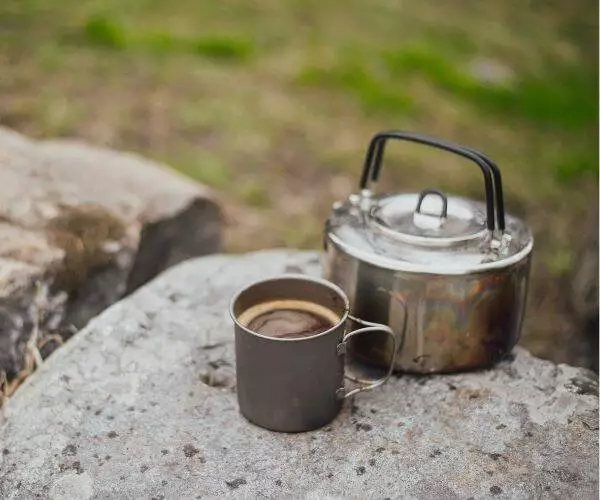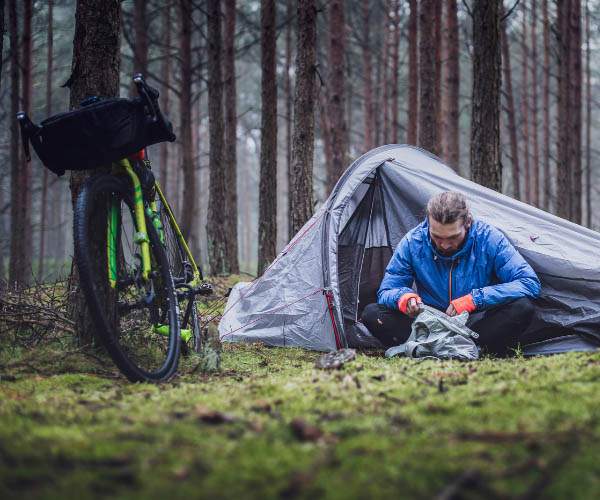Traveling light through bikepacking is much more than just a trend; it's a travel philosophy that can profoundly transform the experiences of many cyclists. Bikepacking offers a minimalist approach to bicycle travel, making it possible to cover long distances unencumbered. By minimizing the weight of your gear, you enhance your agility, boost your speed, and extend your adventures without sacrificing comfort or safety. Lightweight bike touring is a pursuit of efficiency and simplicity that resonates with every cyclist’s spirit of adventure
Learn how to balance lightness and durability, and choose bike accessories that enrich your adventure without adding unnecessary weight. Discover how bikepacking not only lightens your load but also liberates your mind.
The benefits of traveling light with bikepacking
Improved performance
Opting for a lightweight bike and minimalist bike accessories enhances aerodynamics and handling, especially if you choose an aluminum or carbon frame. Whether you're embarking on a bike touring expedition or cycling around the globe, lightness equates to better performance. You’ll ascend hills effortlessly, navigate bike tracks with ease, and maintain consistent speed and endurance on mountain bikes.
Reduced fatigue
A touring bike equipped with a space-saving luggage rack and compact panniers not only reduces weight but also minimizes fatigue. This allows cyclists to focus on pedaling and exploring cycle routes without the burden of unnecessary luggage. The reduced strain on muscles and joints makes long-distance cycling trips much more enjoyable.

Increased range
By reducing gear weight, you expand your range on the road. Carrying less enables you to cover longer and more remote routes or to discover new landscapes while pushing your personal limits.
Flexibility and freedom
Traveling light offers greater flexibility to adjust your itinerary on the fly. A folding bike or a travel bike, designed for easy transport, frees you from logistical constraints, allowing for quick adaptations to weather changes or spontaneous opportunities. Urban bikes, lightweight road bikes , and gravel bikes are ideal for bikepackers seeking maximum flexibility.
Traveling light offers greater flexibility to adjust your itinerary based on weather conditions, unforeseen changes, or last-minute opportunities. Without the limitations of excessive equipment, you can move more freely and adapt to your desires.
Tips for reducing the weight of your gear for bikepacking

Assess your essential needs
Before you depart, take the time to compile a list of your essential needs. Reflect on questions like, 'Is that handlebar bag really necessary?' or 'Does the additional weight of that seatpost justify its use?' Remove any items that aren’t absolutely crucial, like bulky bike racks or luggage racks that add unnecessary weight..
Choose lightweight equipment
Select gear specifically designed for lightweight bike touring and bikepacking , which is typically lighter than traditional options. Look for ultralight bikepacking gear like panniers, tents, sleeping bags, and clothing designed to minimize weight without compromising durability. You could choose travel bike models, or pick lightweight pedals and a crankset that match your cycling style.
Reduce the volume of your clothes
Pack only the necessary clothing for the expected weather conditions. Opt for versatile, lightweight styles that can be layered to adjust to temperature changes, such as cycling shorts and jerseys.
Invest in multi-purpose bikepacking equipment
Select items that serve multiple purposes to maximize efficiency. For example, a detachable double-walled tent is highly versatile, easily converting into either a lightweight tent or a minimalist bivouac tent as needed. Similarly, Inwild straps offer remarkable flexibility by eliminating the need for a heavier mounting system. They can be adeptly used to secure bikepacking bags and panniers to the fork or attach water bottles to the frame. Flat pedals allow you to wear any shoes you prefer, while clipless pedals help increase your pedaling power.
Limit bike accessories and gadgets
Refrain from burdening your bike with unnecessary accessories. Focus on the essentials such as a bike repair kit, a headlamp, and a multifunction tool. Evaluate the necessity of each water bottle, lock, or saddle bag, remembering that every gram is crucial when you aim to minimize your overall weight.
Optimize your food for lightweight cycling
Opt for light, high-energy foods like cereal bars, dried fruit, and dehydrated meals to keep your energy up without adding much weight. Steer clear of heavy and bulky items like tinned or fresh produce that could weigh down your panniers. If feasible, plan to purchase meals daily during your journey to avoid carrying surplus food.
Minimize unnecessary items
Thoroughly evaluate each item you plan to bring and discard anything that isn’t absolutely essential. Limit your clothing, accessories, and gadgets to the bare essentials to lighten your load. Some bikepackers even go to the extent of cutting down items to essentials, such as trimming the handle of a toothbrush, to ensure their gear is as lightweight as possible.
These strategies will help streamline your packing and enhance your experience, allowing you to enjoy bikepacking adventures with less weight and more freedom.




